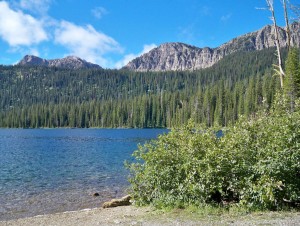
Dave Hadden of Headwaters Montana passed this along the other day. Conservation organizations concerned about the Kootenai and Idaho Panhandle National Forests chalked up a win last Thursday in their fight to protect recommended wilderness areas in the two forests . . .
Missoula, MT – A federal judge today upheld important protections for some of the last unspoiled areas of the Kootenai National Forest in northwest Montana and the Idaho Panhandle National Forests in northern Idaho.
In a decision issued this morning, U.S. District Judge Dana L. Christensen rejected a challenge by snowmobilers that sought to overturn the U.S. Forest Service’s wilderness recommendations for areas including the Scotchman Peaks and Roderick Mountain in Montana and the Mallard Larkins and Selkirk Range in Idaho. The judge ruled that the Forest Service has broad authority to manage recommend wilderness areas to preserve their wilderness values, including through limiting motorized and mechanized use in these wild and remote areas.
The ruling came in response to a lawsuit filed by the Ten Lakes Snowmobile Club and other off-road vehicle groups in November 2015 that asked the court to open the protected areas to motorized use.
The recommended wilderness areas at issue represent some of the last wild areas in the otherwise heavily roaded Kootenai and Idaho Panhandle forests. These areas provide important habitat for mountain goats, grizzly bears, Canada lynx, wolverines, and a wide variety of other species, including the only remaining population of woodland caribou in the continental United States. And they provide an opportunity for hiking, horse packing, snowshoeing, and backcountry skiing in a wild setting.
“Preserving the region’s last wild and remote areas maintains the integrity of our public lands,” said Earthjustice attorney Aurora Janke, who represented a coalition of conservation groups that intervened in the lawsuit to defend recommended wilderness. “Today’s decision is a major victory for these special places in Montana and Idaho and for the preservation of recommended wilderness in all our national forests.”
The conservation coalition defending the recommended wilderness decisions includes The Wilderness Society, Headwaters Montana, Idaho Conservation League, Montana Wilderness Association, Panhandle Nordic Ski and Snowshoe Club, and Winter Wildlands Alliance.
“We are pleased that the court rejected this unfounded attempt to limit the Forest Service’s authority to manage recommended wilderness areas to preserve their wilderness values,” said Peter Aengst, Senior Director of the Northern Rockies region for The Wilderness Society. “Protecting the wilderness character of recommended wilderness areas is essential to the long-term preservation of these irreplaceable landscapes for present and future generations.”
“This decision validates longstanding efforts of our members and volunteers to ensure non-motorized, wilderness protection for the most wild and deserving areas of the Kootenai National Forest. This includes lands adjacent to the Cabinet Mountains Wilderness, areas in the Yaak, and Scotchman Peaks,” said Amy Robinson, northwest field director for the Montana Wilderness Association. “By affirming the Forest Service’s authority to manage recommended wilderness to protect wilderness values, this decision ensures that these areas will maintain the potential for future wilderness designation.”
“We are pleased to see the Court uphold the Forest Service’s discretion to maintain these areas’ wild character. Today’s decision ensures that those who seek solitude and the opportunity to encounter winter on its own terms will be able to have those experiences on these forests well into the future,” said Hilary Eisen, Winter Wildlands Alliance Recreation Planning and Policy Manager.
“This court decision demonstrates that the Forest Service can and should protect the last vestiges of wilderness land on our national forest,” said Dave Hadden, director of Headwaters Montana. “The Kootenai and Panhandle forests are heavily devoted to timber and motorized recreation. This decision protects the small percentage of wild country for wildlife and for people seeking a wilderness experience.”
Earthjustice, the nation’s premier nonprofit environmental law organization, wields the power of law and the strength of partnership to protect people’s health, to preserve magnificent places and wildlife, to advance clean energy, and to combat climate change. Because the earth needs a good lawyer